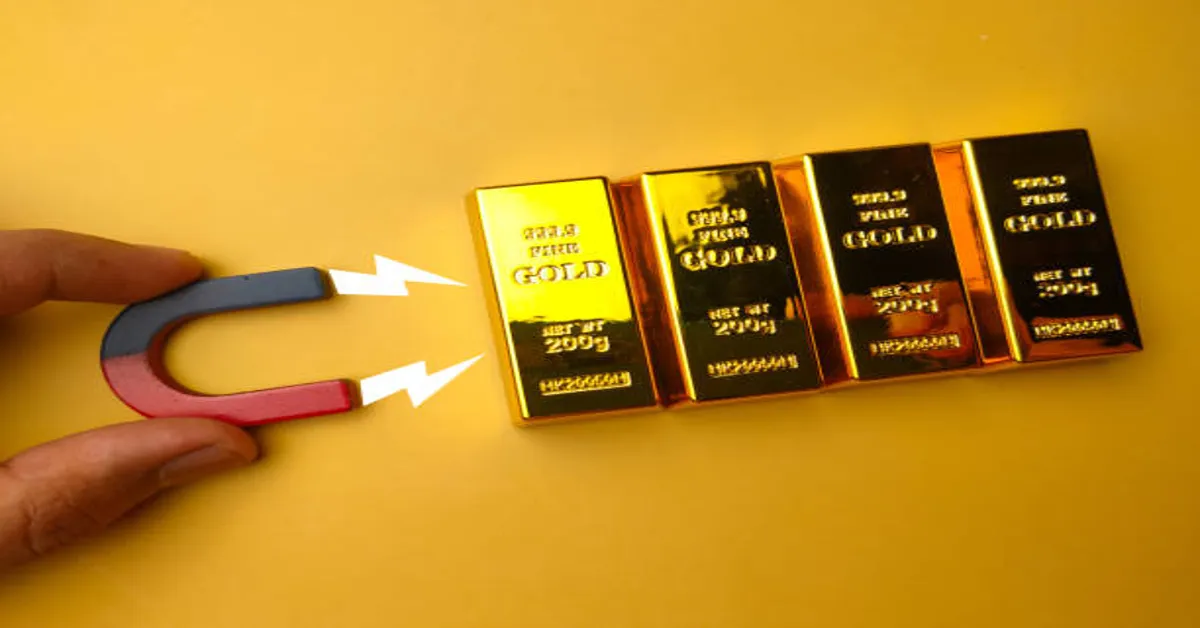Gold has been one of the most prized metals in human history, valued for its rarity, beauty, and remarkable physical properties. From ancient civilizations crafting jewelry and coins to modern industries using gold in electronics and aerospace, this precious metal has played a vital role in culture, economy, and technology. Yet, despite its widespread recognition, many people still wonder about a fundamental property of gold: is gold magnetic?
This seemingly simple question opens the door to a fascinating discussion that blends physics, chemistry, and material science. Gold’s relationship with magnetism is not as straightforward as with metals like iron or nickel, which are strongly magnetic. Instead, gold sits in a unique category that makes it intriguing both to scientists and the general public.
In this article, we will explore the magnetic properties of gold in depth, how it behaves under different conditions, why it is classified as it is, and what practical applications and implications these characteristics have in real life. By the end, you will have a clear, detailed, and comprehensive understanding of whether is gold magnetic and why.
Understanding Magnetism in Metals
To answer whether is gold magnetic, it is essential first to understand what magnetism means in scientific terms. Magnetism arises from the movement of electrons, particularly their spin and orbital motion around the nucleus. Depending on how the electrons are arranged in a material, different types of magnetism may occur.
Types of Magnetism
| Type of Magnetism | Description | Examples of Materials |
|---|---|---|
| Ferromagnetism | Strong attraction to magnets, ability to retain magnetization permanently. | Iron, Nickel, Cobalt |
| Paramagnetism | Weak attraction to a magnetic field, disappears when the field is removed. | Aluminum, Platinum |
| Diamagnetism | Weak repulsion from a magnetic field, no permanent magnetization. | Gold, Copper, Bismuth |
| Antiferromagnetism | Adjacent atomic spins align in opposite directions, canceling each other. | Manganese oxide |
| Ferrimagnetism | Unequal opposing spins lead to some magnetization. | Magnetite (Fe₃O₄) |
As seen in the table, gold does not fall under the ferromagnetic category like iron. Instead, gold exhibits diamagnetism, a property that makes it weakly repelled by magnetic fields. This weak repulsion is so small that it is nearly imperceptible in everyday situations.
Is Pure Gold Magnetic?
Pure gold, also called 24-karat gold, is not magnetic in the sense most people understand. If you bring a regular magnet close to a pure gold coin, bar, or piece of jewelry, it will not stick. This is because gold’s electrons are arranged in such a way that they do not align with magnetic fields to produce attraction.
However, the story does not end there. Although gold is not ferromagnetic, it does exhibit very weak diamagnetic behavior. This means that when exposed to a strong magnetic field, pure gold will experience a minuscule repulsion. In practical terms, this is almost invisible without sensitive scientific instruments.
So, if someone asks, “Is gold magnetic?” the accurate answer is:
- No, gold is not magnetic in the everyday sense.
- Yes, gold is weakly diamagnetic, but the effect is negligible under normal conditions.
Why Gold is Diamagnetic
The explanation lies in gold’s atomic structure. Gold has the atomic number 79, meaning it has 79 protons in its nucleus and 79 electrons orbiting around it. The way these electrons are distributed in shells and subshells is what determines its magnetic properties.
In gold, the electron shells are filled in such a way that most electron spins cancel each other out. This leads to no unpaired electrons that could contribute to ferromagnetism or strong paramagnetism. Instead, when an external magnetic field is applied, tiny induced currents in the electron orbits oppose the magnetic field slightly. This opposition is what we call diamagnetism.
This phenomenon is common in many noble metals like silver and copper, but gold’s relatively heavy atomic weight gives its diamagnetic effect a slightly more noticeable edge, though still far too weak to be observed casually.
Gold Alloys and Magnetism
While pure gold is not magnetic, the situation changes when gold is alloyed with other metals. Most gold jewelry is not pure 24-karat gold but instead mixed with metals such as copper, silver, nickel, or zinc to increase durability and change color. These alloys can sometimes display magnetic properties depending on the added metals.
Examples of Gold Alloys and Magnetic Behavior
| Alloy Composition | Common Use | Magnetic Behavior |
|---|---|---|
| 18K Gold (75% gold + 25% alloy metals) | Jewelry | Usually non-magnetic, unless iron or nickel are present. |
| 14K Gold (58% gold + 42% alloy metals) | Jewelry | May show weak magnetism if alloy contains nickel. |
| White Gold (Gold + Palladium/Nickel) | Rings, Watches | Nickel-based white gold may respond weakly to magnets. |
| Gold-Plated Metals | Costume jewelry, electronics | Strongly magnetic if base metal is steel or nickel. |
This explains why some gold items might respond to magnets. It is not the gold itself that is magnetic, but rather the alloying metals or base materials underneath thin gold plating.
Practical Applications of Gold’s Magnetic Properties
Although gold is not magnetic, its diamagnetic nature and chemical stability make it extremely useful in several scientific and industrial applications.
Electronics and Electrical Applications
Gold is an excellent conductor of electricity and resists tarnishing. In electronics, thin layers of gold are used in connectors, switches, and printed circuit boards. Its non-magnetic property ensures that magnetic interference is minimized, which is crucial in high-precision devices.
Medical Applications
In medicine, gold nanoparticles are used in imaging, targeted drug delivery, and cancer treatment. The fact that gold is non-magnetic makes it compatible with MRI (Magnetic Resonance Imaging) systems, preventing unwanted interactions with strong is gold magnetic fields.
Aerospace and High-Precision Instruments
Satellites, spacecraft, and advanced instruments use gold for reflective coatings, electrical contacts, and shielding. Again, the absence of magnetism means that gold can be used safely in sensitive environments without risk of interference.
Misconceptions About Gold and Magnets
Many myths surround the idea of gold being magnetic. Let us clarify some common misconceptions.
- “If gold is real, it won’t stick to a magnet.”
This is only partly true. Pure gold is non-magnetic, but some alloys or gold-plated items may show magnetism due to other metals. - “Magnetism is a reliable test for gold purity.”
Not true. While pure gold will not be attracted to a magnet, many fake gold items are made of non-magnetic metals like copper, which will also not stick. Therefore, magnet tests are unreliable as a sole method of testing authenticity. - “Gold can be made magnetic with strong magnets.”
Even in very strong magnetic fields, gold only shows weak diamagnetism. It will not turn into a magnet or be strongly attracted.
Scientific Experiments with Gold and Magnetism
Scientists have studied gold’s diamagnetism extensively. In laboratory conditions, when gold is placed in an extremely strong is gold magnetic field, it is observed to slightly repel the field. This effect is so weak that it requires highly sensitive instruments to measure.
Additionally, research into gold nanoparticles has revealed interesting quantum effects that sometimes alter is gold magnetic response. At the nanoscale, properties of materials can differ significantly from their bulk form, leading to ongoing studies in nanotechnology.
How to Test Gold with Magnets
While magnets are not a definitive test of gold’s authenticity, they can provide some clues. Here’s how:
- Bring a Strong Magnet Near the Gold Item
- If the item sticks strongly, it is likely fake or gold-plated over steel or nickel.
- If there is no attraction, it could be real gold or another non-magnetic metal.
- Look for Weak Reactions
- Pure gold will not react at all.
- Alloys may show slight attraction depending on their composition.
- Combine with Other Tests
- Acid tests, density measurements, and professional assays are more reliable.
| Test Method | Accuracy | Notes |
|---|---|---|
| Magnet Test | Low | Good for quick screening, but not conclusive. |
| Acid Test | Medium | Can damage item if not done carefully. |
| Density Test | High | Real gold has density of 19.3 g/cm³. |
| Professional Assay | Very High | Most accurate and definitive. |
The Cultural and Historical Perception of Gold’s Purity
Throughout history, people have devised ways to test whether a gold item was genuine. In ancient times, biting into a coin was one method, since gold is soft and would show teeth marks. In modern times, people often assume magnets can detect fake gold.
The persistence of the magnet test myth shows how important authenticity is in societies where gold represents wealth and security. However, science teaches us that magnetism is not a reliable indicator of real gold.
Conclusion
So, is gold magnetic? The answer is nuanced. Pure gold is not magnetic in the way ferromagnetic metals like iron are. Instead, gold is a weakly diamagnetic material, repelling rather than attracting magnetic fields, though the effect is so small that it is invisible in everyday life. When alloyed with other metals, however, gold jewelry and items may show is gold magnetic properties depending on the added materials.
This unique property, combined with gold’s stability and conductivity, makes it invaluable in electronics, medicine, and aerospace. While magnets can provide some information, they are not reliable tests for gold’s authenticity. Instead, proper scientific and professional methods are required.
In the end, gold remains one of the most fascinating metals on Earth—not just for its beauty and economic value but also for the subtle complexity of its physical properties.
FAQs
1. Is pure gold magnetic?
No, pure gold is not magnetic. It is a diamagnetic material, which means it weakly repels magnetic fields but is not attracted to them.
2. Why does some gold jewelry stick to a magnet?
This usually happens because the jewelry is an alloy containing metals like nickel or because it is gold-plated over a magnetic base metal.
3. Can magnets be used to test real gold?
Magnets can give some indication, but they are not reliable. Many non-gold metals are also non-magnetic, so a magnet test alone cannot confirm authenticity.
4. Does gold become magnetic at the nanoscale?
Gold nanoparticles can sometimes show unusual magnetic properties due to quantum effects, but bulk gold remains diamagnetic and non-magnetic in everyday use.
5. Why is gold used in electronics if it is not magnetic?
Gold’s lack of magnetism, combined with its excellent conductivity and resistance to tarnish, makes it ideal for use in sensitive electronic components.









